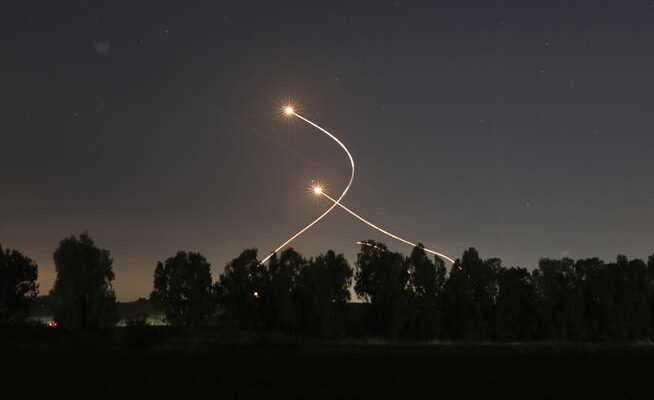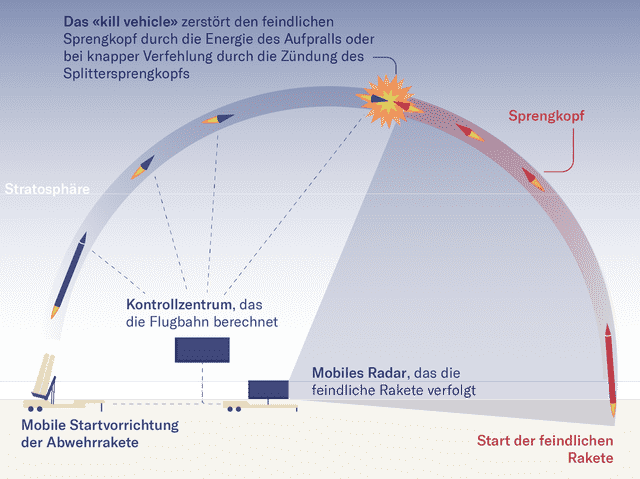The federal government is considering buying protection against Russian missiles in Israel. Approval comes from the opposition. Experts are meanwhile skeptical and warn against quick fixes.
Iron Dome missiles rise near the Israeli city of Sderot in May 2021 and intercept missiles from Gaza.
Germany’s turning point in security policy is entering the next round. After better equipment for the neglected Bundeswehr, the country has been discussing setting up a protective shield against Russian missiles for a few days. The threat to large parts of Europe from Russian weapons is not new. Years ago, Russia stationed missiles in its enclave of Kaliningrad that could reach the German capital in five minutes. But it’s only since the Russian invasion of Ukraine that people in Germany seem to have felt really threatened.
Now it should be quick. A protective shield could be stretched over the Federal Republic as early as 2025 – if Israel buys the Arrow 3 anti-missile defense system. This is currently being considered in the federal government and the parties supporting it. Accordingly, Arrow 3 batteries together with missile radar systems could be set up at three locations in Germany. According to experts, the rumored costs of two billion euros seem to be based on very preliminary assumptions.
Chancellor Olaf Scholz himself did not give any details during a television appearance, but confirmed that there were considerations of setting up a missile protection shield for the whole of Germany based on the Israeli model. A final decision has not yet been made. This week, German parliamentarians in Israel learned about the Arrow 3 system.
Iron Dome provides protection against short-range missiles
Israel is one of the leading countries in anti-aircraft defense. The Arrow 3 system, developed in cooperation with the USA, can intercept medium-range missiles at very high altitudes using maneuverable defense missiles. Probably no other country has to use its systems so often for self-protection. Above all, the so-called Iron Dome has made it famous. It protects about 90 percent against short-range rocket fire, for example from Hamas. The David’s Sling and Arrow 3 systems are designed to protect against threats from higher altitudes.
Also at night there were rocket attacks on residential areas in #Israel. This is where the life-saving anti-missile system catches #IronDome Hamas rockets over #Sderot away.#IsraelUnderAttack pic.twitter.com/K4bpnzWMeQ
— Israel in Austria (@IsraelinAustria) May 18, 2021
But can Germany safely shield itself with technology from Israel under an iron dome? Carlo Masala, professor at the Bundeswehr University in Munich, pours water into the wine. From his point of view, it is a kind of feel-good policy. The population is led to believe that they can make themselves comfortable under a protective umbrella. But that is not the case. No system currently available on the market offers complete protection against Russian attacks, certainly not across the board – especially when they occur simultaneously and in large numbers, he tells the NZZ.
“Russia is a different house number than Iran”
“Arrow 3 was designed with Iran’s threat in mind. The system is not really battle-tested. In addition, Russia is a different house in terms of the number and capabilities of its medium-range missiles.” What if Russia launched 60 missiles simultaneously, plus decoys to confuse radars? The political scientist is certain that this would quickly push any system beyond its limits.
In addition, shortly before the attack on Ukraine, Russia fired a hypersonic missile to intimidate it. This was an older model. However, there is currently no protection at all against the more modern version. So can you save yourself the procurement of strategic air defense? The security expert does not want to go that far.
“We must be able to parry what the Russians can”
Masala welcomes both the discussion and the purchase of a system. But Germany must first clarify what threat it wants to protect itself against – and then go on a shopping spree, he says. From his point of view, sooner or later there will be no avoiding a debate similar to that of the NATO double-track decision-making process in the early 1980s. “You have to draw level with your opponent if you want to deter him permanently.” In other words: Germany and the NATO partners cannot avoid retrofitting medium-range missiles.
The CSU member of the Bundestag Florian Hahn also sees it that way. “We have to be able to parry what the Russians can,” says the defense policy spokesman for the Union faction of the NZZ. But there is no way around expanding air defense. “A large part of Russia’s 850 nuclear-capable SS-26 medium-range missiles are stationed in Kaliningrad,” he says. “We finally have to do something about it.”
He has great sympathy for Arrow 3. It is true that with high simultaneous fire every system reaches its saturation limit. But that’s not the point. You have to make it clear to the opponent that you have defensive abilities yourself. In addition, a missile shield saves valuable time in the event of a conflict in order to be able to implement other measures such as troop deployments.
Attacks with mini drones would be a problem
Hahn puts pressure on the “traffic light”. In his view, the special fund of 100 billion euros for the better equipment of the Bundeswehr must also be used for the expansion of the neglected air defense overall.
In fact, Germany has capability gaps not only in the area of strategic anti-aircraft defense against medium-range enemy missiles. Time has not stood still in the case of close and medium anti-aircraft defense either. True, there are ready-to-use systems such as the stationary system Mantis and the mobile Ozelot. But modern mini-drones would overwhelm the ocelot system, experts believe.
The Patriot system, which the Bundeswehr uses for air defense at medium altitudes, is also showing its age. This offers good protection against classic ballistic missiles. But according to experts, the Patriots have nothing to oppose to newer types of missiles that fly at low altitude and whose trajectory can be controlled.
A further development or a replacement for the Patriots has therefore been discussed for a long time. In 2014, the development of the MEADS defense system was completed. The so-called tactical air defense system, which should bring the air defense of the Bundeswehr up to date, is based on it. However, the Bundestag pulled the emergency brake in 2020, mainly because of the escalating costs.
There are no more air raid shelters
Anyone who talks about air defense cannot remain silent about civil defense. And Germany is not doing well there either. A spokeswoman for the German Federal Office for Civil Protection and Disaster Assistance told the NZZ that there is a warning system for voltage and defense situations. This is currently being improved. However, ready-to-use public shelters such as air raid shelters no longer exist. The dismantling of the shelters began in 2008.
Against the background of the current situation, it is being examined whether a reorganization is necessary. As a first step, the federal government, together with the federal states, wants to take stock of the existing shelters in a timely manner. This shows that Germany’s security policy turning point has only just begun and is likely to take a long time. The omissions of the past few years are too great.


